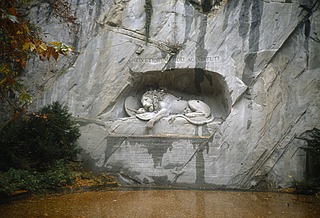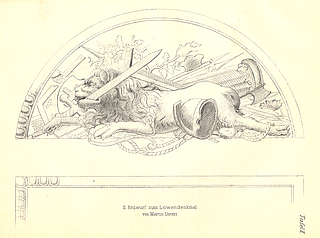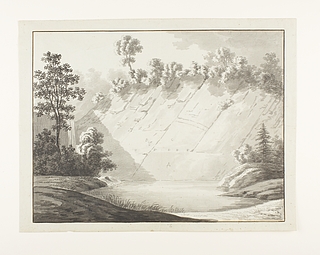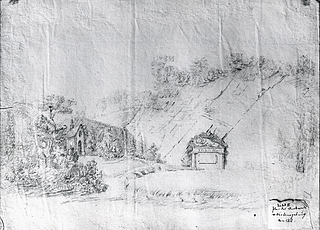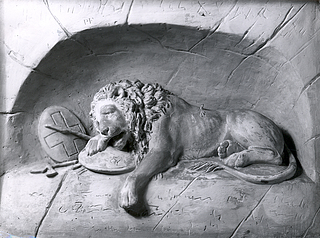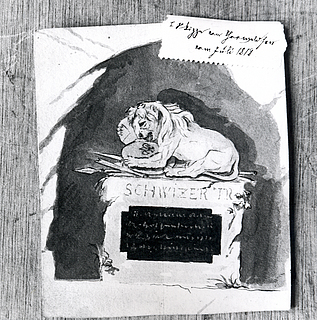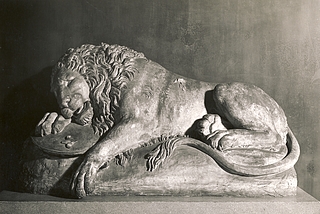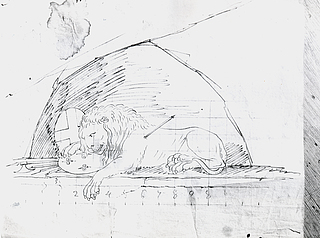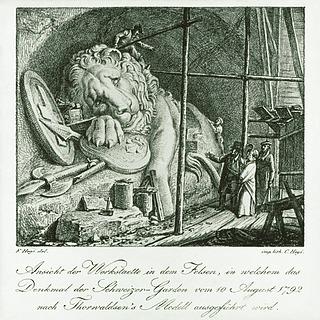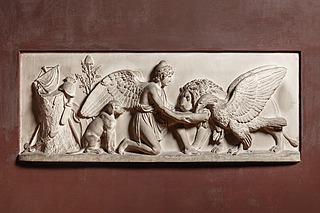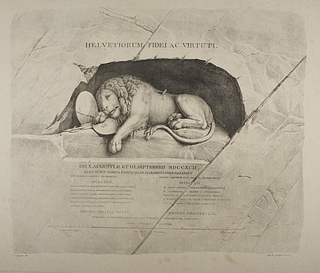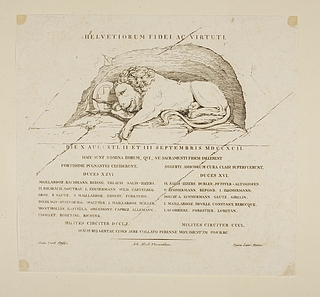Dying Lion (The Lucerne Lion) - a national-political monument with built-in controversy
- Kira Kofoed, arkivet.thorvaldsensmuseum.dk, 2013
- Translation by David Possen
In 1818-1819, Thorvaldsen produced the model for a monument to the Swiss Guards who had fought in Paris in defense of King Louis XVI, the absolute monarch of France, during the storming of the Tuileries by revolutionary forces on August 10, 1792. When the Dying Lion was dedicated in Lucerne, in 1821, pro-democracy circles criticized it as a tribute to royal power. In fact, however, Thorvaldsen may have embedded within the work a discreet critique of absolute monarchy as a form of government. This article begins by recounting the monument’s story, and proceeds to offer a more critical account—as, with time, it has grown to be more of a national symbol of Swiss values than a memorial for the mercenary soldiers that it actually names.
- 1. A national-political monument with built-in controversy
- 2. Background: Dutiful mercenaries and national values
-
3. History of the commission
[+]
- 3.1. The initiative
- 3.2. A matter for the nation
- 3.3. Thorvaldsen’s interest is aroused
- 3.4. Requirements and models
- 3.5. Thorvaldsen’s pencil-drawn sketches
- 3.6. Thorvaldsen’s models
- 3.7. Delay
- 3.8. Shipment of the models; their reproduction on a grand scale
- 3.9. Dedication and politically-motivated protests
- 4. The lion: a question of interpretation [+]
- 5. Documents [+]
- 6. References
A national-political monument with built-in controversy
“Wear away though it may, this monument will nonetheless stand tall above all others”: this is a pronouncement that Thorvaldsen is himself supposed to have made about his Dying Lion, Lucerne Lion, Lion of Lucerne, Lion Monument, or Swiss Lion, as the monument—which stands by an old sandstone-quarry lake in Lucerne’s Glacier Garden—is variously called.
The Lucerne Lion was executed in colossal size, but this size is difficult to discern from photographs. The grotto containing the lion measures a full 13 m in width; the lion itself is 9 m long.
Background: Dutiful mercenaries and national values
The background for this monument, one of Thorvaldsen’s most famous works internationally, is an historical event that took place during the French Revolution, when Thorvaldsen himself was still a young man living in Copenhagen. On August 10, 1792, the 1100-man strong Swiss Guard regiment protecting the Tuileries, a palace of King Louis XVI in Paris, was defeated when the palace was stormed by Revolutionary forces. In practice, the Swiss Guards were professional mercenaries, who in this case were in the employ of the French monarchy. The storming of the Tuileries led to a massacre of the guards, who ultimately surrendered their weapons, reportedly on the orders of the king. Of the Swiss Guards who survived the storming, many were killed soon afterwards, some directly by the mob; others were hauled before a military tribunal of the Legislative Assembly, and then hanged on September 2 and 3. All in all, approximately 650 Swiss Guards were killed during the Tuileries raid on August 10, and approximately 200 more were hanged subsequently. Only about a fifth of the regiment survived.
The new French regime supported liberal-democratic forces in the Swiss Confederation, and transformed it into a centralized Helvetic Republic. Later, the Confederation was reestablished by the 1803 Act of Mediation, which was dictated by Napoleon, though the Swiss Confederation remained a vassal state under French domination. It was only at the Congress of Vienna, in 1814-1815, that Switzerland gained recognition as an independent confederation of independent states. Even then, however, there remained large internal tensions, resulting from disunity between liberal and conservative forces.
These political tensions, along with a preoccupation with the country’s newfound independence, were also evident in the discussions surrounding the Lucerne Lion. For how could one create a monument to mercenaries who had fought for the King of France during the French Revolution in a country that has just been liberated from French hegemony? And how could such a monument not only incorporate a conservative, loyalist element, as the commission’s patron wished, but also serve, simultaneously, as a national symbol for a unified people—all within a confederation that valued freedom, independence, and autonomy?
This difficult task was entrusted to Thorvaldsen in the spring of 1818, when the patron in question—the former Swiss Guardsman Karl Pfyffer von Altishofen—persuaded Thorvaldsen, through the middleman Vincenz Rüttimann, to produce a model for the monument for the modest price of 300 scudi. In principle, this was a narrowly constrained task: Pfyffer requested a representation of a dead lion surrounded by broken weapons. The lion was to symbolize the soldiers’ courage, strength, and willingness to die rather than to betray their oath of service. Thorvaldsen thought poorly of the idea of a dead lion, preferring a living, resting beast. They compromised on a dying lion.
The monument Dying Lion (The Lucerne Lion) was ultimately carved in colossal size, following Thorvaldsen’s model (cf. the plaster cast, A119), directly into a cliff face in Lucerne’s Glacier Garden. Before that day arrived, however, both the patron and the middleman, and perhaps Thorvaldsen too, came to be consumed by impatience and irritation because of the events of the commission’s history—which will next be described in detail.
Thorvaldsen’s sketch of the monument to the Swiss Guards that was to be erected at Lucerne, C1127. The final drawing by Thorvaldsen, which was delivered to the commission’s patron, Karl Pfyffer von Altishofen in Lucerne, is not extant.
History of the commission
The initiative
While in the Swiss Guards, Karl Pfyffer von Altishofen had served in Paris during the French Revolution; but he was home on leave when the dramatic events at the Tuileries took place. The officer Bachmann, listed among the names of the fallen officers inscribed on the monument in Lucerne (cf. the photograph of the inscriptions at the bottom of this article), was Pfyffer’s uncle, and it was he who had had Pfyffer inducted into the Swiss Guards. After 1792, Pfyffer remained in service—first for the King of Sardinia, and then for Austria. In 1801, his regiment was disbanded, and Pfyffer returned to Lucerne. Here he began secretly preparing plans for a monument that would honor and memorialize his comrades who had fallen in Paris.
During the period of Napoleon’s rule over Switzerland, ending in 1815, Pfyffer’s wish was a political impossibility. With the advent in 1814-1815 of both Swiss independence and restoration of the Bourbon royal family in France, however, Pfyffer was finally able to work openly toward his goal. On August 7, 1817, the Swiss Confederation’s Diet (Tagsatzung, or legislative assembly of delegates from the various cantons) voted to compile a list of all the Swiss Guardsmen who had taken part in the battles, both the fallen and the survivors. All of these were to be awarded a memorial medal of iron with the words “Fidelity and Honor,” and the list of names was to be preserved for posterity in the Confederation’s archive.
This measure prepared the ground for the additional (and far more visible steps) that Pfyffer held it necessary to take. On March 1, 1818, Pfyffer sent out a so-called subscription plan to start raising funds for a monument “in honor of the military staff of the former Swiss Guard regiment in French royal service, who died on August 10 and September 2 and 3, 1792.”
Subscription contribution receipt dated 28.7.1819,
with an early sketch of the Lion monument. Click on the date to see the document and read its text.
A matter for the nation
Pfyffer’s original wish was that the monument be conceived and produced entirely by Swiss nationals. Martin Usteri (1763-1827), an illustrator and poet living in Zürich, had already sent Pfyffer several proposals for the monument by 1817, but neither he nor Pfyffer were satisfied with the result. Nor did Pfyffer’s relative, the architect Louis Pfyffer von Wyers (1783-1845), succeed with his own sketch of a Vendôme-inspired column with four lions on the pedestal. In 1818, as a result, Pfyffer issued an invitation to all Swiss artists to produce models for the monument; these were to be displayed in Bern and Zürich at the exhibitions of the Swiss art association later the same year. None of these suggestions, however, roused enthusiasm in Pfyffer either; and so he was forced to think outside the borders of his own land. Pfyffer’s friend and artistic advisor, the former sculptor Heinrich Keller, suggested that he approach either Thorvaldsen or Canova—with a preference for Thorvaldsen, for reasons of both style and price.
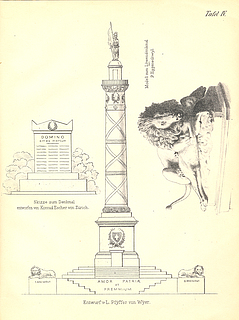 |
 |
| Sketch and model of the monument by Konrad Escher (1767-1823), Louis Pfyffer von Wyer (1783-1845), and Pankraz Eggenschwyler. Reproduced from Liebenau, op. cit., Table 4. | Sketch of the monument by Martin Usteri (1763-1827). Reproduced from Liebenau, op. cit., Table 1. |
Second sketch of the monument by Martin Usteri (1763-1827). Reproduced from Liebenau, op. cit., Table 2.
Thorvaldsen’s interest is aroused
The task of persuading Thorvaldsen to accept this commission, even though he was already fully occupied, was passed on to one of Pfyffer’s friends, the influential Vincenz Rüttimann. From March 18 until shortly after August 8, 1818, Rüttimann was in Rome in his capacity as Landvogt (prefect) and head of government of Lucerne, in order to negotiate with the Curia, the central administrative body of the Roman Catholic Church.
The difficulty consisted not merely in squeezing yet another commission onto Thorvaldsen’s calendar, but also in the fact that the money so far raised could hardly suffice to pay Thorvaldsen or his studio to produce anything more than the model for the monument. This fact, then, needed to be hidden from Thorvaldsen until the delivery of the model. Meanwhile, Rüttimann played up little Switzerland’s glorious and freedom-loving past, as well as it history of poverty. In his letter to Thorvaldsen dated 16.5.1818, Rüttimann refers to the Swiss as “poor devils,” who are hardly rich in “the silver and gold of great men.”
Such a description presumably made a favorable impression on Thorvaldsen, who occasionally—and likely with his own poor background in mind as well—let socially conscious thoughts shine through.
It may seem paradoxical that anti-monarchical ideals of equality and the Revolutionary spirit should have been used as implicit means of persuasion here, given that this monument was intended to honor those who had fallen in defense of the absolute monarchy par excellence in France.
According to Liebenau, an additional means of persuasion was provided by a painting of the landscape garden that was to serve as the monument’s backdrop: its picturesque appearance supposedly helped persuade Thorvaldsen to accept the commission. Unfortunately, this painting is no longer extant. It cannot be identical with the drawing, D1515, which both Friis and Felder claim is identical to this visual means of persuasion. This is because the drawing mentioned by Friis and Felder was not sent to Thorvaldsen until after he had requested a variety of information about the location where the final monument was to be produced.
This drawing of the cliff face and its surroundings, with relevant measurements indicated etc., is still extant in Thorvaldsen’s collection of drawings, as The garden at Lucerne, indication of placement of The Lucerne Lion, D1515. Thorvaldsen requested considerable specific information about the landscape, perspective, etc., in order to be able to fashion a fitting monument. On this see Rüttimann’s letter dated 16.5.1818, along with the letter dated evidently either on 23.5.1818 or on 28.5.1818, which provide keys to the diagram labels in the drawing above.
The garden in which the monument was to be erected lay on the outskirts of Lucerne, by the foot of Wesemlin Hill, and was owned by the commission’s patron, Pfyffer von Altishofen. Since 1805, Pfyffer had worked to remodel this plot of land, which had previously held a sandstone quarry, into an English landscape garden. The sheer cliff face remaining from the land’s quarrying days now ended in a small quarry lake, and Pfyffer’s idea was to carve the monument into the cliff face over the water.
Sketch displaying the monument’s location in the landscape garden that Pfyffer had established on the outskirts of Lucerne, in and around a retired standstone quarry by the foot of Wesemlin Hill. The artist who produced this drawing has not yet been identified.
Requirements and models
According to the call for subscriptions, the original idea for the monument was to let it be produced as “a bas-relief on a large scale, representing a dead lion in natural size, which despite being weighed down by a mass of broken weapons, still safeguards, under its body, the shield with the insignia of France and Switzerland.” There should, moreover, be “a brief, appropriate inscription, as well as a list of the names of the brave who died as martyrs for their fidelity.” It was imagined that both the relief and the plate to be placed underneath it, bearing the names of the warriors, would be cast in iron or copper; but Thorvaldsen wished that it be cast in bronze. On this see the letters dated 16.5.1818, 19.11.1818, and 7.9.1818.
At first glance, this image—a lion buried in a crush of weapons—seems quite bombastic, not to mention far too chaotic for a neoclassical sculptor. Perhaps it was these concrete demands that led to the fact that, according to Pfyffer, no Swiss artist was able to complete the task. Martin Usteri’s sketched proposals, reproduced above, can be taken as examples of this.
Thorvaldsen did agree to deliver a drawn sketch and produce a model, but he insisted that the lion be portrayed not as dead, but as alive and resting. Nevertheless, Thorvaldsen ultimately compromised, as mentioned above, and agreed to render the lion as dying.
The weapons, too, are less prominent in the two models produced by Thorvaldsen than in Pfyffer’s call. The smaller model in relief displays only a spear and the tip of a helbard, along with a short piece of the spear that had wounded the lion; the larger model reveals only a small remnant of the broken spear that had dealt the lion its mortal blow. On the other hand, both shields—the French, with the three lilies, and the Swiss, with the cross—were retained both in the smaller model and in the finished colossal sculpture. The Swiss shield, however, is much clearer than the French, which is partly covered by the lion. The larger original model includes only the French shield.
According to Heinrich Keller, this smaller model of the monument, which displays the lion lying in a niche, was produced by Thorvaldsen himself, whereas the larger model (displayed below) is the work of assistants following Thorvaldsen’s sketch and model.
As far as is known today, Thorvaldsen had previously portrayed lions in his sculpture on only two occasions. The first of these was in his youth in Copenhagen, when he (presumably working together with his father) produced four stone lions with which to decorate two gates to Frederiksberg Gardens at Frederiksberg Runddel. These lions are no longer extant. The second occasion was in the relief Alexander the Great’s Entry into Babylon, A505, where a pair of lions is visible among the gifts presented at Alexander the Great’s triumph. Ironically enough in the present context, this long frieze was installed in Rome’s Quirinal Palace in order to honor none other than Napoleon I, victor of the French Revolution, who was expected to enter the city in 1812.
By this point, Thorvaldsen had not yet seen a living lion himself, but had to rely on illustrations or other representations. In particular, Antonio Canova’s tomb monument for Pope Clement XIII (1693-1769) (installed in St. Peter’s Basilica in Rome in 1792) seems to have served as a model for Thorvaldsen:
The reclining lions in Antonio Canova’s Monument to Pope Clement XIII (1693-1769), installed in 1792 in St. Peter’s Basilica in Rome, appear to have been a strong source of inspiration to Thorvaldsen, who did not see a living lion until 1822. The above is an 1830 reproduction of Canova’s monument by copper engraver Raphael Morghen, E873.
Thorvaldsen’s pencil-drawn sketches
Two drawn sketches by Thorvaldsen himself are extant, namely, C1127 and C215, both dating to 1818. A third sketch is ascribed to Thorvaldsen by Liebenau and Felder, but this sketch has so little in common with Thorvaldsen’s other drawings and images of lions that it cannot plausibly have been made by him.
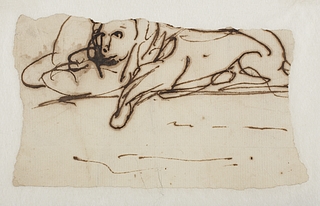 |
 |
Already in these early sketches—of which the fragmented C215, at left, must be presumed to be the earliest—the outstretched forepaw, pointing at the inscription below, has become a fixed element. In this initial sketch, the lion is clearly alive, resting, and not dying, just as Thorvaldsen initially wanted it. Meanwhile, in the second, more developed sketch, C1127, at right, whether other, pencil-drawn versions may be discerned underneath, the deadly lance is added, and the eyes are hardly open any more. This version of the now-dying lion is quite close to the final sculpture, and must be within the same ballpark, at least, as the drawing that was delivered to Rüttimann and subsequently sent to Pfyffer.
Unfortunately, this final drawing of the lion is not itself extant. As mentioned, however, it must have been quite similar to C1127, and it presumably also served as the basis for the reproductions that are visible, for example, in the publication Geschichte des 10 August 1792 in Paris und Bericht über Entstehung des Löwendenkmals in Luzern für die an jenem Tage gefallenen Schweizer-Garden [History of August 10, 1792, in Paris, and Report on the Emergence of the Lion Monument in Lucerne for the Swiss Guards who Fell on that Day], Lucerne [1821-22]:
A contemporary engraving reproduced in Pfyffer von Altishofen’s publication on the occasion of the monument’s erection, Geschichte des 10 August 1792 in Paris und Bericht über Entstehung des Löwendenkmals in Luzern für die an jenem Tage gefallenen Schweizer-Garden [History of August 10, 1792, in Paris, and Report on the Emergence of the Lion Monument in Lucerne for the Swiss Guards who Fell on that Day], Lucerne [1821-22]. This may well be the engraving that most closely resembles Thorvaldsen’s now-vanished final drawing of the monument. Evidently, however, there were significant “translation problems” in the transition from drawing to engraving—particularly with respect to the lion’s maw.
As mentioned previously, a shaded pen drawing has been attributed to Thorvaldsen falsely as the monument’s final sketch. If this drawing had been the one sent to Pfyffer (which is highly doubtful), then it was not by Thorvaldsen himself; for with its rather unhelpful and nearly caricatured expression, it bears no resemblance either to the sculptor’s other sketches or models of the monument (cf. C215, C1127, A119, or to the smaller relief of the the lion in the grotto, as described in the section on Thorvaldsen’s models below), nor to Thorvaldsen’s casual figural representations in general. The draftsman behind this drawing is presently unknown, as is the reason for its ascription to Thorvaldsen.
A shaded pen drawing of the lion monument, falsely attributed to Thorvaldsen. The actual draftsman is presently unknown.
Thorvaldsen’s models
It can be established with certainty that Thorvaldsen produced two clay models—a small maquette or bozzetto, which was evidently reworked and cast as the exemplar now on display at the Museum of History in Lucerne:
Thorvaldsen gave this small model to Heinrich Keller, who later passed it on to Pfyffer; and it was from Pfyffer’s descendants that it made its way to the Lucerne Museum of History. According to Keller, this model’s special attraction was that it had been wholly produced by Thorvaldsen himself.
The smaller model also served as the basis for a larger clay model, as was the practice in Thorvaldsen’s studio. The latter clay model was produced by Thorvaldsen’s students, and evidently (as was usual) was lost during its plaster casting. The original model, i.e., its first plaster cast, was sent to Lucerne, and is found there today in the city’s Museum of History:
A second cast was kept by Thorvaldsen in his studio, and stands today in Thorvaldsens Museum, A119:
Delay
According to Liebenau, most of the work of completing the lion in large scale in clay was passed on to Thorvaldsen’s assistants Luigi Bienaimé and Pietro Tenerani. The latter was to take responsibility for the lion’s paws and mane, as he was especially talented at making hair—and so, it was hoped, fur as well. The work was gradually begun in January 1819; cf. Keller’s letter dated 6.1.1819. However, a later missive by Keller, dated 17.6.1819, reveals that the work in January consisted only in preparing a surface on which the model of the lion was to be made, and that the actual work of modeling the lion in clay only began in May 1819. The entirety of April was consumed by work on Pietro Tenerani’s own sculpture series Venus and Amor. According to Keller’s letter dated 6.1.1819, and Rüttimann’s letter dated 1.1.1819, Thorvaldsen planned to have the model finished and cast in plaster approximately two months later, i.e., during the month of March.
Drawing based on Thorvaldsen’s smaller model of the lion reclining in the grotto, with measurement markings. The draftsman was presumably Heinrich Keller, who drew the model after abandoning his earlier attempts to persuade Thorvaldsen himself to do so.
In the meantime, Thorvaldsen’s studio was fully booked with both old and new commissions; see Thorvaldsen Year by Year for a list of the tasks undertaken that year. In addition, Thorvaldsen spent part of the spring in ever more intensive planning for his travel to Denmark, and caught fever several times; on this see Thorvaldsen Year by Year. Work on the model of the Lion monument also coincided with an emotionally hectic spring for Thorvaldsen, in which his engagement to Frances Mackenzie ended, while his flirtation with Fanny Caspers got underway.
By Thorvaldsen’s own standards, one may say that the model was produced relatively quickly. The contract for the commission, or its closest approximation, must be regarded as Rüttimann’s letter dated 7.9.1818, where both the price and the task are confirmed. The model was finished just before 3.7.1819, when Keller reported that it had finally been cast in plaster—i.e., barely ten months later. For the patron Pfyffer von Altishofen, however, this was an unreasonably long delay; and Keller, Pfyffer’s “enforcer” in Rome, was clearly frustrated and disappointed by what he regarded as Thorvaldsen’s infuriating sluggishness and indifference toward the people waiting for his work. This led to an open quarrel between Keller and Thorvaldsen, which is described in their letters dated 17.6.1819 and 19.6.1819. For his part, Thorvaldsen was clearly irritated at being commandeered and rushed; he retorted that art is not a standard product like a glass bottle, and in any case a few weeks here or there would make no real difference.
The original model of Dying Lion (The Lucerne Lion), which was sent to Lucerne and is found today in the Lucerne Museum of History.
It seems to have been the weapons, in particular, that were responsible for the delay on Thorvaldsen’s end. On this see Keller’s letter dated 17.6.1819, where these decorative elements are mentioned as being all that was missing. Given that on the final model, cf. A119, only the French coat of arms is displayed, it does not appear that Thorvaldsen obeyed Keller’s demands on this account. Only on the smaller model of the lion in the grotto can the Swiss coat of arms and two weapon fragments—the tip of a helbard, and a spear—be seen; but this is a model that Thorvaldsen had promised to produce during the course of his quarrel with Keller (see above). All the same, other letters suggest that this smaller model may instead be a reworking of the maquette or bozzetto (modeled sketch) that Thorvaldsen had produced in January and February 1819.
Shipment of the models; their reproduction on a grand scale
By the time the larger model of the lion was finally completed and cast in plaster, Thorvaldsen had already departed for Denmark. On August 4, 1819, Thorvaldsen received his payment of 300 scudi via Banco Brancadori; cf. the workshop accounts for the period August 1819 – March 1820. Heinrich Keller made certain that the model was packed and sent to Lucerne on 7.8.1819. The smaller model of the lion in the grotto had been sent ahead a week in advance, on 2.8.1819. The larger model arrived at its destination broken into pieces, but was plastered together again, with some effort, so that it could be used for its original purpose, namely, as a model for the carving of the final monument.
The actual task of carving the monument into the cliff face at the old sandstone quarry in Lucerne was originally assigned to the Swiss sculptor Pankraz Eggenschwyler. Eggenschwyler, however, fell during the work and was wounded fatally; the German sculptor Lucas Ahorn arbejdet then took over and completed the work. Ahorn is thus evidently the man crawling on the lion’s mane in this contemperaneous engraving by Franz Hegi, E1810.
It was the Swiss sculptor Pankraz Eggenschwyler who was assigned the actual task of carving the lion monument, following Thorvaldsen’s model, directly into the sandstone cliff-face. He began carving on 19.8.1819. During the work, however, Eggenschwyler fell from the scaffolding, and was wounded so badly that he died as a result. His replacement was the German sculptor Lucas Ahorn, who arrived in Lucerne in January 1820, and completed carving the colossal lion between 28.3.1820 and 7.8.1821. Thus it was that, directly in opposition to the plan of erecting a wholly Swiss monument, the Lucerne Lion was ultimately produced by a Dane and a German. Thorvaldsen himself paid a brief visit to Lucerne during his trip to Denmark on 12.8.1819; but at that point the carving had not yet been begun.
Dedication and politically-motivated protests
The Lucerne Lion was dedicated on 10.8.1821, the twenty-ninth anniversary of the storming of the Tuileries on August 10, 1792. Pfyffer von Altishofen had arranged that a memorial mass for the fallen Swiss Guards be held in the Court Church of St. Leodegar in Lucerne, in order to emphasize that the dedication was meant to memorialize the fallen and fighting soldiers, rather than a victory celebration or occasion for national self-glorification. Prince Christian Frederik of Denmark, later to become King Frederik VIII was among the prominent guests as the dedication, and he described the ceremony in a letter to Thorvaldsen dated 12.8.1821. Judging by the Prince’s letter, the monument seems to have received nothing but praise once it was unveiled: “[a] deep feeling descended on all; the eulogies were unanimous; no more fitting, more beautiful memorial could be imagined.”
The only things that disturbed the Prince were the day’s violent rains, which forced postponement of the dedication ceremony by the monument itself, and a long, “drawn-out repetition of the names,” which were read aloud in the church as part of the dedication ceremony. Meanwhile, more important negative reactions to the dedication could be heard from other quarters. As the following comment makes clear, some were enraged by the lack of Swiss national “fingerprints” on both the monument’s content and its creation:
Es ist nur zu bedauern, dass das Löwendenkmal nicht in Paris steht, wo die Tapfern fielen, dass es für eine fremde Sache dasteht und von einem fremden Künstler entworfen ist und von einem fremden Bildhauer ausgeführt wurde. Alles fremd, nichts Schweizerisches daran!
This, for example, was the verdict of the physicist, politician, and philosopher Ignaz Paul Vital Troxler (1780-1866). And a 2009 doctoral dissertation fra 2009 inscribes the selfsame Troxler into Swiss history as the father of modern, democratic Switzerland. In May 1821, Troxler became president of the Helvetic Society, which had been founded in 1761/1762 in Schinznach Bad with the goal of spreading and furthering Enlightenment ideas of freedom and democracy. On August 20, 1821, i.e., immediately following the dedication of the Lucerne Lion, Troxler started publication of the journal Fürst und Volk [Prince and People], which at the time was regarded as revolutionary to the extreme; he was attacked by conservative circles for glorifying the Revolutionary regicide in France.
Generally speaking, pro-democracy circles in Switzerland regarded the Lucerne Lion as strongly reactionary and royalist. In their view, because the memorialized soldiers fell in defense of Louis XVI, the monument was ultimately a glorification of absolute monarchy. In the neighboring town of Küssnacht, students sympathetic with liberal and pro-democracy circles organized a counter-demonstration on the day of the monument’s dedication. The newspapers of the day also reported that there had been attempts by liberal democrats to destroy the monument, as well as violent street protests, in which the above-mentioned Troxler, among others, was assaulted by partisans of the conservative line, and a campaign of intimidation against democratically-minded students commenced. One spokesman for the pro-democracy wing, the Francophobe professor Wolfgang Menzel (1798-1873) (characterized vividly by Liebenau as Franzosenfresser, “the French-devourer”), wrote the following many years afterward, in his memoirs, about these political disturbances and the intense polemical focus on the monument:
Nach der Restauration fühlte diese Aristokratie recht wohl ihre Unfähigkeit auf eigenen Füssen stehen zu können, schloss sich daher eng an die wieder auf den Thron gelangte ältere Linie der Bourbons an. Das äussere Zeichen dieser Verbindung war der Löwe, welcher zum Andenken, der für Ludwig XVI. am 10. August 1792 in Paris gefallenen Schweizergarden bei Luzern aus dem natürlichen Felsen gehauen wurde. Es war ein schöner Gedanke, die Treue jener todesmuthigen Männer zu ehren, allein es wurde eine reactionäre Demonstration daraus gemacht, so dass sich die Herzen vieler Schweizer dagegen verschlossen.
In diese Zeit muss man sich zurücksetzen, um zu begreifen, warum der Löwe von Luzern in der Schweiz nicht populär war. Man vergass die schöne welthistorische That der rothen Garden über dem politischen Druck und Schwüle der Gegenwart. Doch ist der Löwe nicht für jene Tage allein ausgehauen worden. Er wird noch kommenden Jahrhunderten von Schweizertreue erzählen.
Am 10. August 1821 wurde der Löwe feierlich enthüllt. Es hätte von rechtswegen ein Nationalfest der ganzen Schweiz sein sollen, allein es betheiligte sich dabei nur die Aristokratie. Von allen Seiten strömte dieselbe herbei und die Strassen von Luzern wimmelten von Greisen in den altmodischen rothen Uniformen der frühern Schweizergarden und von alten Damen mit grünen Brillen und Hässlichen Hüten. Man glaubte sich einen Augenblick an den aus den Gräbern wieder auferstandenen Hof Maria Antoniette’s versetzt.
In sum, polemics surrounding the lion monument and its justification, placement, and symbolization emerged before, during, and after its installation. It was only after many years that the monument became a national memorial; see also Menzel’s account above.
The lion: a question of interpretation
Traditionally, the lion is a symbol of strength, bravery, and power. In iconography, lions are often linked to those at the zenith of society—kings, princes, popes—implicitly suggesting that they defend their land or faith with a lion’s courage, endurance, and power. In the Danish context, this connection is perhaps most recognizable in King Frederik III’s famous silver lions in the Knight’s Room at Rosenborg Castle. In classical antiquity, one of the best-known examples is the royal castle at Mycenae (1200 BC), where the entrance gate is crowned by a limestone relief with two lions.
By contrast, Pfyffer planned the Lucerne Lion as a different kind of lion: rather than symbolizing the strength of monarchical power, it was to embody the bravery, fidelity, and courage of the Swiss soldiers (whereas the king himself first retreated to safety, and then reportedly ordered the soldiers to surrender; see above). It therefore appears that, in Pfyffer’s desired imagery—and so in Thorvaldsen’s work—King Louis XVI was to be represented by the French coat of arms: a “passive” shield, passive inasmuch as it does not protect itself, but allows itself to be protected (here by the lion).
Put briefly, it was not the act of the king or the monarchy that was heroic, but that of the soldiers; and this is a clear departure from the message sent by the lions at Rosenborg. We can accordingly speak of a democratization and dehierarchization of the lion qua symbol of power—both by Pfyffer and by Thorvaldsen.
An embedded critique?
Once we accept that Dying Lion (The Lucerne Lion) involves the democratization of the lion symbol, we can interpret this symbol as one that assigns monarchical power a role that is not especially glorious, and instead ascribes courage and power to the ordinary man. Perhaps it is also in this context that Thorvaldsen’s insistence on reproducing a living, resting lion should be understood.
In order to approach Thorvaldsen’s own thinking more closely, we will need to rely on the few sources that are closest to his own hand or mouth—such as the allegedly direct citations in letters to Pfyffer from Rüttimann and Keller, and the few written sources deriving from Thorvaldsen himself. In what follows, moreover, certain other statements that may be relevant to this reading will also be discussed.
In response to an extremely adulatory mention of The Lucerne Lion, and particularly of Thorvaldsen’s model of the dying lion, cf. A119, Thorvaldsen’s friend and amanuensis, the archaeologist P. O. Brøndsted, wrote the following in a draft reply on the sculptor’s behalf:
Für was Sie mir in Ihrem lieben Brief Wohlwollendes und Ermunterndes von meinem Model zu dem ehrwürdigen Denkmal Helvetischer Tapferkeit und Treue sagen, empfangen Sie meinen besten Dank. Das grösste Lob gebührt aber den patriotischen Männern, zu welchen hr. Obrist von Pfyffer und Ew. Hochwohlgeb. selbst gehören, welche die schöne Idee gefasst haben und selbige auszuführen rastlos bemüht gewesen sind. Mir rechne ich es zu der grössten Ehre dass ich zu einem wahrhaft nationalen Denkmal eines so tapfern und weltberühmten Volks in Etwas habe behülflich seyn können. Von meinen schon ziemlich zahlreichen Werken wüsste ich bis jezt keine der eine schönere Bestimung geworden sey.
This citation clearly emphasizes that, in Thorvaldsen’s view, the Lion monument honored the role of the Swiss people in their small republic, rather than the select group of named officers who were honored de facto. The key words in the above citation are Helvetische Tapferkeit und Treue [Swiss bravery and fidelity], die patriotischen Männer [the patriotic men], and ein wahrhaft nationales Denkmal eines so tapfern und weltberühmten Volks [a truly national memorial for such a brave and world-famous people]. Neither absolute monarchy nor the events of the French Revolution are named explicitly. Instead, the monument is clearly granted the associations that it later came to enjoy almost exclusively: that is, it became a tribute to a bravely fighting, freedom-loving people. Rather pointedly, Thorvaldsen’s account of the monument omits all reference to professional mercenaries, who are true to their oath of service (irrespective of particular political allegiances) rather than to political or national ideals of freedom.
Thorvaldsen’s wish to represent the lion—in this context, the symbol of the people—as living and not dead is even more central. It can perhaps be connected to the wish for a democratic future, in which the people, rather than the prince, will be of highest importance. The Danish poet Jens Baggesen’s 1825 poem about the monument lends support to this reading: the experiential difference between these two forms of representation, dead or living, is articulated clearly in Baggesen’s poem. The poem’s emphasis on “the living” may be thought to interpret the monument’s motif as a broad tribute to Swiss bravery (past and future), rather than merely to memorialize the names of Swiss Guardsmen who fought in a particular battle at a particular moment in history:
Verwundet liegt er da, doch muß ich heben:
Sein Blick ist sterbend, doch sein Anblick droht;
Ich zweifle nämlich nicht an seinem Leben;
Ich zweifle nur an seinem Tod.
Another sign that Thorvaldsen presumably aimed to promote egalitarian associations with the monument can be found in his expressed wish that the soldiers’ names be inscribed without any sign of artificial rank or order. In a letter to Pfyffer dated 20.2.1819, Keller conveyed Thorvaldsen’s wish: Die Namen ohne Ordnung auch kolloßal darunter schreiben, größer [und] kleiner, daß keine Genauigeit und Fleiß dabei sichtbar ist wie der Charakter des Ganzen es erheischt. The reason for this is assumed to be the relation between the monument and what one might call the “orderly disorder” of the surrounding landscape garden; but it could just as well be to emphasize the equality of officers and enlisted men, who were all equal in courage, bravery, and loyalty. The final result in Lucerne’s Glacier Garden, however, does not reflect Thorvaldsen’s wish for a non-hierarchical inscription; cf. the photograph of the inscription below.
In sum, the monument and its altered use of the lion as a symbol can be thought to indicate that it is royal power that is dying, and that relations between king and people are in flux. The lion here becomes a symbol of the Swiss people’s bravery and courage. Perhaps this was Thorvaldsen’s quiet critique, despite the constrained nature of his assignment, of a form of government that would only come to an end in his own fatherland later, with the advent of the Constitution of 1849. Perhaps this was the sculptor’s way of legitimizing his monument and bringing it up to date. This emphasis on the Swiss people’s values and bravery has presumably also contributed to the fact that over time, and despite its contentious reception and quite specific original historical context, The Lucerne Lion has won recognition as a monument whose symbolic value does indeed approximate the national symbol that democratically-minded circles clamored for in Thorvaldsen’s own day.
Thorvaldsen’s own political view?
There is no extant documentation to support the claim that Thorvaldsen himself became explicitly political, whether privately or in his artwork. All we have are more or less clear intimations, as above. Presumably Thorvaldsen valued the freedom to accept commissions from all comers over any desire to adopt a clear political stance.
Nevertheless, reports by contemporaries suggest that Thorvaldsen was critical of absolute monarchy as a form of government. As an older man, for example, the sculptor conspicuously declined to appear at the coronation of Christian VIII; what is more, he added a revolutionary symbol to one of his reliefs after learning that it had been interpreted as a royal homage.
If Thorvaldsen’s valet, C.F. Wilckens, is to be believed, the sculptor revealed a good dose of skepticism toward the monarchy in his relief The Genius of Peace and Freedom, A529. The first version of the relief was an image of Peace as a concept, here in the peaceful company of a lion and an eagle, who drink from the same basin. In the original version, the kneeling man with wings—a so-called genius—did not have a hat on his head; and the tree with a hat on top, along with the tree stump with discarded weapons, were not present either.
Bertel Thorvaldsen, The Genius of Peace and Freedom, 1844. Original model. Plaster. 75.0×190.5 cm. Thorvaldsens Museum, A529.
At the time, such a hat was called a “freedom hat,” and such a tree was called a “freedom tree.” The hat was associated not only with classical antiquity, but also with the Jacobin hat of the French Revolution, which became a popular symbol of freedom and democracy. Thorvaldsen, therefore, changed the relief in order to display Freedom as a concept as well.
According to Wilckens, the reason for the change was that the press had interpreted the relief as honoring the upcoming wedding of a Danish prince to a Russian grand duchess. And Thorvaldsen did not wish to have his work associated (exclusively) with this royal context: “It could very well be that someone would think that, and perhaps there is something to it; but now I must put on the freedom hat.”
Thorvaldsen was also linked to liberal-democratic circles through his ties to the Philhellenic Committee, for whom he had produced the monument to the freedom-loving poet, author, and enfant terrible George Gordon Byron; cf. A130.
In 1839, when Thorvaldsen was awarded the Grand Cross of the Order of the Dannebrog, he was required to design a coat of arms and choose a personal device; and here too, the concept of freedom became an important element. Thorvaldsen had initially chosen the motto Kjærlighed til Fædrelandet [Love for the Fatherland]; but the poet Adam Oehlenschläger criticized this choice: “You are a man of freedom … and so you should use the words: Frihed og Kjærlighed til Fædrelandet [Freedom and Love for the Fatherland].” “You deserve thanks for that!” Thorvaldsen responded. “You know me precisely, and you know that it was to preserve my freedom that I did not want to get married. Now it shall be as you say.”
With this, Oehlenschläger was presumably referring not simply to Thorvaldsen’s unmarried status, but rather to his continuing insistence on artistic freedom in relation to his works and place of residence. It is also probable that this declaration of freedom went even deeper, and applied also to the political-civil freedom that had emerged in the wake of the struggles that led to the French Revolution.
Given his juggling of commissions from princes, nobles, citizen committees, and the Philhellenes, this balancing act between political extremes was presumably no easy matter for Thorvaldsen. Nor had his work on the Lion monument been a morally uncomplicated affair, as its contentious reception by its contemporaries also indicates.
It cannot be established with certainty that Thorvaldsen—by his insistence on the lion’s being still alive, his downplaying of the monument’s concrete political background, and his call for a “disorderly engraving” of names—wished to bend the monument’s associations in a democratic direction. Yet these examples do suggest that, in his own quiet way, Thorvaldsen implanted a discreet critique of authoritarian forms of government within his work.
Documents
The monument’s inscription
[Above the grotto:]
HELVETIORUM FIDEI AC VIRTUTI
[Underneath the grotto:]
DIE X AUGUSTI, II ET III SEPTEMBRIS MDCCXCCII
HAEC SUNT NOMINA EORUM QUI NE SACRAMENTI FIDEM FALLERENT
| FORTISSIME PUGNANTES CECIDERUNT DUCES XXVI [names of 26 fallen officers] MILITES CIRCITER DCCLX |
SOLERTI AMICORUM CURA CLADI SUPERFUERUNT DUCES XVI [names of the 16 surviving officers] MILITES CIRCITER CCCL |
HUIUS REI GESTAE CIVES AERE COLLATO PERENNE MONUMENTUM POSUERE
ABSOLUTUM DIE X. AUGUSTI MDCCCXXI.
| Studio Caroli Pfyffer. | Arte Alberti Thorvaldsen. | Opera Lucæ Ahorn. |
The inscription underneath the Lion monument in Lucerne.
Contemporaneous reproductions and mentions of the monument
Following the installment of the Lion monument in Lucerne, several reproductions and publications appeared either in connection with the monument’s dedication on 10.8.1821 or subsequent to it. One single publication from the dedication itself is found in Thorvaldsen’s book collection: M18,11, Alois Gügler, Der 10te August 1792: der Schweizergarden zu Paris; Bei der feierlichen Eröffnung des ihnen gestifteten Denkmals zu Luzern: den 10ten August 1821; Melodramatisch dargestellt am Vorabend Desselben [The Tenth of August, 1792: the Swiss Guards of Paris: At the Festive Inauguration of the Monument Dedicated to Them in Lucerne, August 10, 1821: Presented Melodramatically on the Evening Before the Same], Lucerne 1821. See also a facsimile of this publication here.
In 1822, the monument’s patron, Pfyffer von Altishofen, published an account of the monument’s origins and historical background, namely, Geschichte des 10. August 1792 in Paris und Bericht über Entstehung des Löwendenkmals in Luzern für die an jenem Tage gefallenen Schweizer-Garden [History of August 10, 1792, in Paris, and Report on the Emergence of the Lion Monument in Lucerne for the Swiss Guards who Fell on that Day], Lucerne 1822. Both a German and a French edition of this publication are found in the library of Thorvaldsens Museum, though neither of these editions derive from Thorvaldsen’s estate.
The drawing of the monument Dying Lion (The Lucerne Lion) by the Swiss draftsman and painter Jakob Schwegler (1793-1866), which is here converted to a lithograph, E85, is presumably one of the earliest reproductions of the monument made after its completion.
The pictorial reproduction of the Lion monument that is closest in date to its 1821 dedication is, presumably, the lithograph, E85, produced from the drawing of the monument made by the Swiss draftsman and painter Jakob Schwegler (1793-1866), Dying Lion (The Lucerne Lion). The reason for this presumption is that this lithograph is the only contemporary reproduction owned by the museum that was included in Thorvaldsen’s collection of graphic arts. The lithograph was presumably sent to Thorvaldsen by Pfyffer in his letter dated no earlier than 10.8.1821, no later than the end of 1822. Thorvaldsens Museum also houses several contemporaneous versions of Dying Lion (The Lucerne Lion) by Franz Hegi, namely, E1807, E2261, and E2262, and the same Hegi’s Dying Lion (The Lucerne Lion) As It Is Being Executed, E1810, along with contemporaneous works by unknown artists: Dying Lion (The Lucerne Lion), E2260 and E2259. All of these, however, were subsequently incorporated into the collections of Thorvaldsens Museum; cf. Thorvaldsens Museum: Tillæg til Hoved-Katalogen [Thorvaldsens Museum: Appendix to the Main Catalogue], p. 70, The Thorvaldsens Museum Archives. See the Collections for a complete list of reproductions owned by the Museum of the models or the monument.
This early reproduction, Dying Lion (The Lucerne Lion), E2259, whose creator is unknown, may be based on Heinrich Keller’s presumed drawing, which is based in turn on the smaller model of the lion in the grotto. (For reproductions of both the drawing and the model, see earlier in the present article.)
References
- “Das Löwendenkmal zu Luzern,” in: Alpina, vol. 65, no. 5 (May 1939), p. 138-140.
- Alois Gügler: Der 10te August 1792; der Schweizergarden zu Paris: Bei der feierlichen Eröffnung des ihnen gestifteten Denkmals zu Luzern; den 10ten August 1821: Melodramatisch dargestellt am Vorabend Desselben, Lucerne 1821, M18,11. For a facsimile, see here.
- Peter Felder: Das Löwendenkmal von Luzern, Lucerne 1964.
- Finn T. B. Friis: “Schweizerløven i Luzern og dens forhistorie,” in: Meddelelser fra Thorvaldsens Museum, Copenhagen 1947, p. 23-58.
- Daniel Furrer: Gründervater der modernen Schweiz: Ignaz Paul Vital Troxler (1780-1866). Dissertation zur Erlangung der Doktorwürde an der Philosophischen Fakultät der Universität Freiburg (CH), Ph.D. dissertation: University of Fribourg, Switzerland, 2009, available as a PDF file here.
- Theodor von Liebenau: Oberst Carl Pfyffer von Altishofen und das Löwendenkmal in Luzern. Erinnerungsblätter zur Feier des siebenzigjährigen Bestandes der Kunstgesellschaft der Stadt Luzern, Lucerne 1889.
- Précis historique du 10 Août 1792 à Paris et du Monument érigé à Lucerne aux Mànes des Gardes Suisses qui ont succombé dans cette journée avec une Planche lithographiée représentant le monument, Lucerne 1823.
- Carl Frederik Wilckens: Træk af Thorvaldsens Konstner- og omgangsliv, samlede til Familielæsning, Copenhagen 1874, p. 93.
- On the present state of the monument (as of 2007), see the following report on restoration, published by the city parliament (Grosser Stadtrat): Löwendenkmal, Restaurierungsmassnahmen für das Denkmal und den Park, (Notmassnahmen), No. 40, November 8, 2007 (dated September 5, 2007, Ratssitzung [Parliament Session] No. 37).
Works referred to










Last updated 26.01.2023
